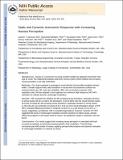Static and Dynamic Autonomic Response with Increasing Nausea Perception
Author(s)
LaCount, Lauren T.; Barbieri, Riccardo; Park, Kyungmo; Kim, Jieun; Brown, Emery N.; Kuo, Braden; Napadow, Vitaly; ... Show more Show less
DownloadBrown-Static and Dynamic Autonomic.pdf (894.5Kb)
OPEN_ACCESS_POLICY
Open Access Policy
Creative Commons Attribution-Noncommercial-Share Alike
Terms of use
Metadata
Show full item recordAbstract
Background—Nausea is a commonly occurring symptom typified by epigastric discomfort with
urge to vomit. The relationship between autonomic nervous system (ANS) outflow and increasing
nausea perception is not fully understood.
Methods—Our study employed a nauseogenic visual stimulus (horizontally translating stripes)
while 17 female subjects freely rated transitions in nausea level and autonomic outflow was
measured (heart rate, HR, heart rate variability, HRV, skin conductance response, SCR,
respiratory rate). We also adopted a recent approach to continuous high frequency (HF) HRV
estimation to evaluate dynamic cardiovagal modulation.
Results—HR increased from baseline for all increasing nausea transitions, especially transition
to strong nausea (15.0±11.4 bpm), but decreased (−6.6±4.6 bpm) once the visual stimulus ceased.
SCR also increased for all increasing nausea transitions, especially transition to strong nausea
(1.76±1.68 μS), but continued to increase (0.52 ± 0.65 μS) once visual stimulation ceased. LF/HF
HRV increased following transition to moderate (1.54±2.11 a.u.) and strong (2.57±3.49 a.u.)
nausea, suggesting a sympathetic shift in sympathovagal balance. However, dynamic HF HRV
suggested that bursts of cardiovagal modulation precede transitions to higher nausea, perhaps
influencing subjects to rate higher levels of nausea. No significant change in respiration rate was
found.
Conclusions—Our results suggest that increasing nausea perception is associated with both
increased sympathetic and decreased parasympathetic ANS modulation. These findings
corroborate past ANS studies of nausea, applying percept-linked analyses and dynamic estimation
of cardiovagal modulation in response to nausea.
Date issued
2011-04Department
Massachusetts Institute of Technology. Department of Brain and Cognitive SciencesJournal
Aviation, Space, and Environmental Medicine
Publisher
Aerospace Medical Association
Citation
LaCount, Lauren T. et al. “Static and Dynamic Autonomic Response with Increasing Nausea Perception.” Aviation, Space, and Environmental Medicine 82.4 (2011): 424–433. Web.
Version: Author's final manuscript
ISSN
0095-6562